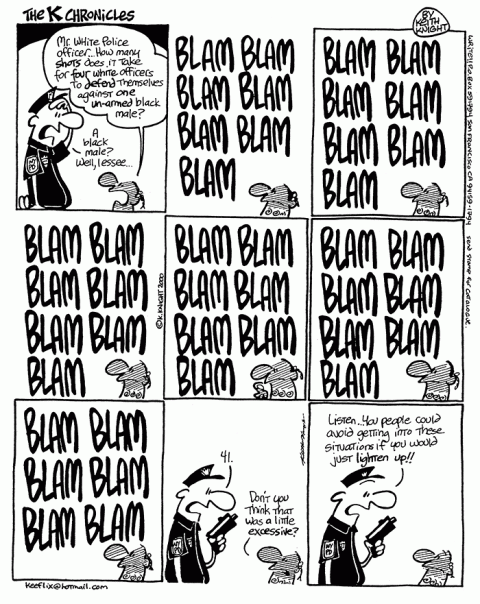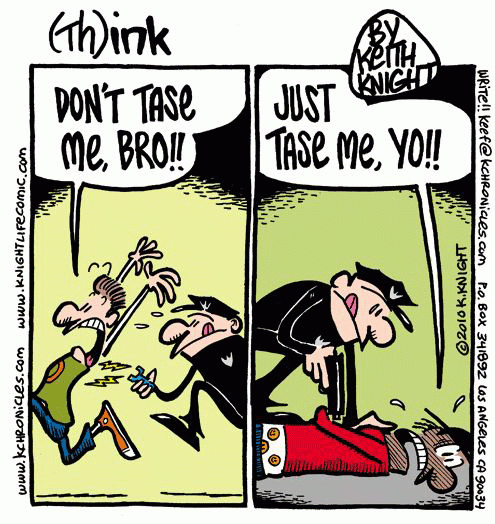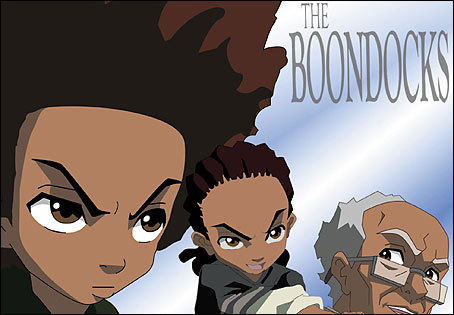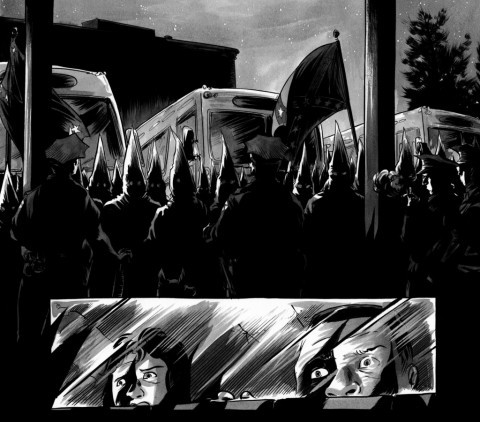[ad_1]

From “They Shoot Black People, Don’t They?” (used by permission of Keith Knight)
AS A LIGHT-SKINNED man fled the sharp sting of a police officer’s weapon, the assembled crowd of a thousand or so let out the loud, full-throated sound of mass laughter. That’s because right next to him was a black man, gun muzzle pressed against his spine as he begged a cop to be simply tased, and the visual jolt that had the crowd smiling was pure electric recognition. This was deep catharsis in the heat of 2015.
On stage, narrating the action, was Keith Knight, an African American cartoonist who had drawn this scene. And in his sure satiric hands, this Saturday-in-summer audience, gathered in downtown Washington to hear from a panel of editorial artists, felt safe to find humor in Knight’s small panels of profound absurdities, which riddle the larger pattern of national tragedy. Knight flipped to a new cartoon, in which a black man asks a white officer why the police’s target-practice figures are black; told that they’re dark because they’re silhouettes, the civilian replies: “I’m talking about the afro and the FUBU logo across the chest.” The crowd again howled. The listeners were in the hands of a master.
Knight has been drawing comics about police brutality and bias for nearly a quarter-century, since the 1992 Rodney King riots, and as the visual commentator likes to note, he was spoofing the racism he witnessed well before he began lampooning presidents. But in some ways, it is only more recently than some audiences have truly caught up to Knight and the realities he renders in his new cartoon slide show, “They Shoot Black People, Don’t They?” Given the coverage that police shootings from Los Angeles to Ferguson to Cleveland to the Carolinas now garner in a world of smartphone cameras and social media, many readers laugh at Knight’s cartoons because they are finally fully cognizant of the context — and because they realize that his satiric bull’s-eyes are painted uncomfortably close to the truth.
Even here, though, rests a pesky professional truth that sits offstage, waiting in the wings. On one hand, cartoonists who can articulate firsthand racism are a valuable voice in the national conversation; indeed, Knight rightly received an NAACP History Maker award this year for his police-prejudice comics. Yet on the other hand, in this era of raised voices for Tamir and Trayvon and Freddie Gray, one journalistic stat stands out to me: Not a single full-time staff political cartoonist on a major American daily newspaper is black, according to the industry’s national professional organization.
As a diversity of voices sounds anew to effect change — and as movements coalesce around related causes — it’s worth remembering one essential from the realm of artistic commentary: Black cartoonists need to be a prominent part of our ongoing national converstation.
So why don’t more editors perceive this need?
.
DARRIN BELL, like Knight, is one of the few nationally syndicated black cartoonists in America — and rarer still are syndicated black cartoonists who are overtly political.
Bell, who lives in Southern California, first syndicated his sometimes topical comic strip “Candorville,” and more recently moved into becoming a political cartoonist. And in commenting on fatal police cases and the resulting unrest in such places as Ferguson and Baltimore, he has found direct, symbolic-image resonance — even receiving an RFK Journalism Award this year for his work. And one crucial element that seems to course through Bell’s cartoons is the point of his passion — there is a certain emotion instilled in the kinetic motion of his lines. Bell himself emphasizes that he draws upon firsthand experience and sense-memory.
“The dynamic between police and the communities they serve is nuanced … [but] civilians don’t sign on to risk our lives whenever we go outside,” Bell has said. “I should feel safe when I’m alone on a sidewalk and see an officer strolling toward me. But I don’t. I feel fear. And the past 33 years of my 40 years on this Earth have given me countless reasons why that fear is rational.” Bell has been quick to note that some of his non-minority cartooning colleagues comment quite incisively on race and police lethality, yet his personal accounts underscore why he feels compelled to lend a voice of color to this dialogue: “What would it mean if I, of all people, were to let these issues slide?”
Case in point: It was announced this week that no officers will be indicted in the shooting death of 12-year-old Cleveland boy Tamir Rice, who held a toy gun when he was struck down. When I hear that, I reflect not only on Bell’s cartoons on such cases, but also upon Bell’s own experience. As a young boy, the cartoonist was once stopped by authorities while refilling a water gun; he heard a chilling “PUT IT DOWN” and saw an officer’s hand go to his unholstered weapon. Just days earlier, Bell’s terrified mother had replaced the boy’s borrowed toy — which looked like a real gun — with a bright, transparent water gun that clearly looked like a toy. That might well have been a lifesaving parental decision. And today, Bell is not only a visual commentator on tragic stories like Tamir Rice’s; his work is also personally informed by his being a parent of color who vows never to let his now-infant son have a toy gun.
These are the types of sociopolitical issues that Aaron McGruder began commenting on nearly two decades ago in his popular syndicated comic strip “The Boondocks,” which ended as his creation was successfully adapted for television. But McGruder has moved on from “The Boondocks,” and no one strip since by a black creator has gained that same high platform.
Bell and Knight now stand as growing voices who have syndicated strips, but as the ranks of staff political cartoonists have shrunk to a few score, it seems no major publication is calling to bring them aboard full-time.
.
IN FEBRUARY of 2008, more than a dozen cartoonists of color joined forces to protest the scarcity of minority creators on America’s comics pages. Knight and Bell created strips for this “sketch-in” campaign, launched by Trinidad-born cartoonist Cory Thomas, for which they all rendered the identical gag, as if their strips were interchangeable. The intent was to spotlight what they viewed as “tokenism” by editors — what participant Lalo Alcaraz characterized as a “one-minority rule,” effectively, for filling slots on the funny pages.
Among staff editorial cartoonists at major dailies, however, the diversity is too minimal to even attempt to apply the word tokenism.
One participant in that 2008 protest was Tim Jackson, then editorial cartoonist at the Chicago Defender, which was launched for an African American readership more than a century ago, and which attracted such contributors as Langston Hughes. And a Hughes contemporary who did pioneering work from the drawing board was Ollie Harrington, who created political cartoons and comics — including the brilliantly satiric Depression-era strip “Dark Laughter” — for such top black-press outlets as the Defender, the Pittsburgh Courier and the Amsterdam News. Harrington became an editorial beacon — the nation’s “greatest African American cartoonist,” touted Hughes — even as he sought political asylum abroad and, as an expat, continued to satirize American politics, from poverty to wars to Watergate.
Yet at major U.S. dailies, attempts to trace the history of black staff cartoonists will lead almost entirely, as it were, to white space.
.
CONGRESSMAN JOHN LEWIS was due to speak soon at the granddaddy of American geek-culture conventions when, in the spirit of the event, he decided to don a costume. And there was only one heroic outfit he had in mind. On the ground in San Diego this summer, Lewis located a trench coat and a backpack filled with books, an apple, a toothbrush and toothpaste — just the gear he wore a half-century earlier on the day he thought he was going to die.
As a young man in 1965, Lewis helped lead 600 nonviolent protestors across the Edmund Pettus Bridge on the road to Selma, Ala., but at the foot of that span waited troopers who stood not only in their path, but also on the wrong side of history. The bloody events that day would shake the nation and lead later that year to President Johnson’s signature on the Voting Rights Act.
At that pivotal Alabama event, as teargas choked the peaceful marchers, Lewis was beaten unconscious by a trooper till he could be carried back to the safe retreat of a church. Just two years earlier, Lewis had addressed the throngs ahead of the Rev. Martin Luther King Jr. at the March on Washington — the youngest speaker on the dais on that August day. But the quest for equality had meant more clashes, and more nonviolent resistance, and more campaigns to march on higher moral ground.

Selma at 50: A scene from “Bloody Sunday” is the opening sequence to Rep. John Lewis’s civil-rights memoir “March,” as illustrated by Nate Powell. (courtesy of Top Shelf)
Now, precisely 50 years later, Rep. Lewis spoke to a Comic-Con audience while dressed as his 25-year-old self. So when he needed to return to the convention floor, he did what came naturally: He marched through the cavernous hall, leading scores of grade-school students who were moved not only by his stride, but also by his words.
That is because with two-thirds of his civil-rights memoir trilogy now released, Lewis is not only Congress’s first-ever graphic novelist. He has also, at 75, become perhaps the most famous black cartoonist in the United States. This from a passionate national treasure who was called to the civil-rights movement in the first place, while still a teenager in Emmett Till’s Deep South, by a comic book that illustrated and illuminated the nonviolent protests of King and Parks and Gandhi.

In costume as his 25-year-old self, “Selma marcher” Rep. John Lewis leads an impromptu parade of purpose through the halls of the San Diego Convention Center on Saturday during Comic-Con. (photo courtesy of Top Shelf Productions)
I recount that Comic-Con story not only because it illustrates what a prominent sociopolitical cartoonist this civil-rights hero — the last living member of the movement’s Big 6 — has become. By virtue of telling his life’s tale through words and pictures, Lewis is also reaching and teaching children who otherwise might not read.
“March,” co-created with Andrew Aydin and artist Nate Powell, makes for riveting history, as Lewis and his SNCC colleagues face the terror of Freedom Summer buses set ablaze in the Deep South. “March” artfully puts the graphic in “graphic novel” with harrowing and inspiring events re-created with the starkly elegant sweep of black-and-white ink washes. These books should rightfully ring out from every school library, stocked where the next generation can learn what bridges the movement had to cross.
I spotlight “March,” too, because even through comics, John Lewis is a pioneer who refuses to wait for the permission of society’s gatekeepers. In authoring this graphic-novel series, he has become a political cartoonist of sorts without need of a syndicate or newspaper perch.
.
IN THE AGE of the Internet, should black cartoonists, like their visual brethren, even wait on the cultural gatekeepers?
As a sitting congressman and a longstanding protestor, John Lewis knows that it’s not necessarily winners who write history, but rather that the battle is over who controls the narrative — for the narratives that ultimately trump will help define the winners, and perpetuate or redefine which stories are told.
It was a quarter-century ago now that Dwayne McDuffie, a comics creator and pioneering minority-owned business leader, grew so frustrated by the stories that some top comics publishers were telling that he drafted a faux proposal for a new comic: “Teenage Negro Ninja Thrashers.” McDuffie had been drawn to comics in the first place, in childhood, by the ’60s-sprung Marvel superhero the Black Panther, empowered king of Wakanda. Two decades later, though, he was putting the “mock” in mock proposal with his Marvel memo that sardonically spun common and lazy racial tropes of comic-book storytelling — as black superheroes with “bizarre speech patterns” would be aided by their smart and attractive white friends when trouble arose or passions ran high. McDuffie’s swift kicker to his satiric memo was simply: “Have I made my point”?
This matters because McDuffie was trying to increase not only the diversity of not only cartoon characters, but also of who was at the board, getting to create new narratives. He was actively aiming to increase multiculturalism within comics and animation when he co-founded the pioneering Milestone Media in the early ’90s. McDuffie died in 2011, at just 49 years old. But this year, Milestone Media — spurred by McDuffie’s inspiring legacy — announced that it was relaunching, with the goals to create multiculturally rich stories and employ fresh minority talent.
Newspapers, however, present a unique challenge. Historically, the mainstream press didn’t provide a home for pointed black satirists like Ollie Harrington or Wilbert Holloway, as noted by scholar Sheena C. Howard in her recent joint academic work, “Black Comics: Politics of Race and Representation.” Howard, who in 2014 became the first African American woman to win the comics industry’s esteemed Eisner Award, told me last year: “The cultural gatekeeping of race and representation can be seen across all forms of comics, whether we are talking about comic strips, comic books or graphic novels.” Yet Howard points out that the graphic novel is a growing form of publishing, and superhero comics still have a strong and dedicated audience. But by comparison, as the ranks of staff editorial cartoonists have shrunk from a couple-hundred just two decades or so ago, and as the introduction of newspaper comic strips with fair-sized client lists has slowed precipitously, the print newspaper would not appear to be flowing with a wealth of opportunities for new cartoonists, regardless of race or gender or background.
Yet as another week brings word of major announcements in the cases of Tamir Rice and Freddie Gray, as another day brings news of a fatal police shooting in Chicago or Dallas — and as a new Washington Post report says that black men account for 40 percent of the unarmed men shot to death by police this year — it’s worth emphasizing that in most every other realm of the media, we see and hear and receive viewpoints that represent at least a greater degree of racial diversity.
Meanwhile, such political cartoonists as Bell and Knight seek, through syndication and Internet presence, to add to the national dialogue through the prism of their own personal narratives. But what of the full-time staff perch for a black visual commentator?
If only the modern American newspaper were motivated to provide such a home.
[ad_2]
Source link




























